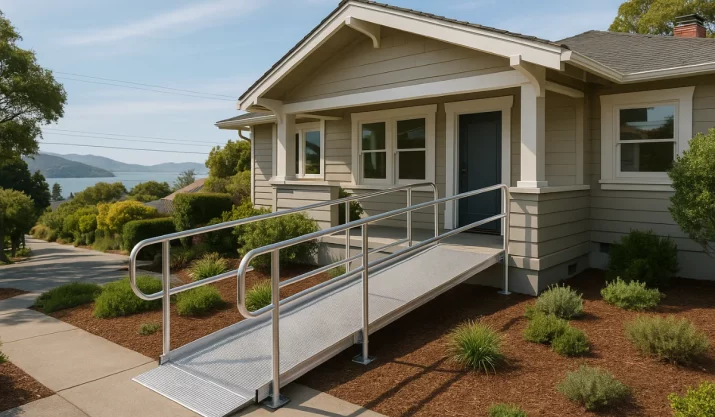What Is the Lightest Mobility Scooter to Lift?

Table of Contents
If you’ve ever struggled to lift a scooter into your trunk or wished for something easier to manage while traveling, you’re not alone. Whether you’re packing for a road trip or simply navigating tight spaces at home, having the lightest mobility scooter possible can make a huge difference.
In this article, we’ll walk you through the lightest folding mobility scooter available today and all the factors that make a scooter easier (or harder) to lift and use.
Key Takeaways
- The Featherweight Scooter weighs only 37 pounds, making it the easiest mobility scooter to lift and store.
- Scooters that fold or disassemble into smaller parts are easier to carry, especially for car travel or storage.
- Lithium-ion batteries weigh less and last longer on one charge compared to sealed lead-acid battery types.
- California Mobility can install scooter lifts and stair lifts with a one-year warranty, return policy, and regular price transparency.
Which Mobility Scooter Is Easiest to Lift?
Right now, the Featherweight Scooter holds the title for the lightest mobility scooter on the market, weighing just 37 pounds without its lithium-ion battery.
That’s lighter than most suitcases!
It’s a foldable, portable mobility scooter that’s designed for users who need something easy to pick up and pack away. Still, the lightest mobility scooter isn’t always the most practical for your needs.
Let’s look at the real-world features that affect how easy it is to lift, transport, and use.
How Total Weight Affects Lifting and Storage
The weight you see on a spec sheet doesn’t always tell the full story. Some mobility scooters advertise their frame weight without including the battery, seat, or armrests. When fully assembled, even an ultra-lightweight scooter can gain 10–15 pounds.
Models that disassemble or fold into carry-on-sized shapes are usually easier to lift in sections, especially if you plan to store them in a car or take them on public transit.
Always check the full weight with all components attached before you decide.
How Folding and Disassembly Features Help With Portability
Scooters that fold with a single-motion latch or automatic mechanism are ideal for travel or daily use. Lightweight folding mobility scooters are designed to be handled with minimal effort, and many even lock into a trolley shape you can roll behind you.
Others disassemble into smaller parts — like the seat, front wheel section, and rear wheel base — so you’re never lifting more than you can manage.
A foldable scooter offers more flexibility than rigid-frame models, especially when you’re low on space.
How Lithium-Ion Batteries Reduce Overall Weight
Most of today’s travel mobility scooters use a lithium-ion battery rather than a heavier sealed lead-acid type. This not only cuts down weight but also improves functionality, with longer performance per single charge and shorter charging times.
They’re usually easy to remove, too, so you can lift the scooter separately and charge the battery indoors using a standard charger.
How Frame Materials and Parts Impact Mobility
Featherweight frames made from aircraft-grade aluminum can significantly reduce a scooter’s overall weight without compromising durability.
You’ll still want to make sure the scooter’s weight capacity matches your needs — most lightweight mobility scooters support up to 250 or 300 pounds.
Make sure to consider how parts like the tiller, handlebars, or seat height adjustments add to the weight or change the lifting angle. Even design details like a larger front wheel or rear wheel can increase the load you’re lifting.
How Specific Features Influence Liftability
Scooters that come loaded with comfort features — think adjustable seat backs, padded armrests, high top speed, or brushless motors — tend to weigh more.
If your priority is lifting and storage, go with a minimalist design. That might mean giving up a bit of comfort, but you’ll benefit from easier handling and a more manageable scooter.
Consider if you’ll need the scooter for outdoor use or cruising long distances, too.
A lighter model with a short driving range might be perfect for errands but not ideal for trails or hills.
How Your Travel Plans Guide Your Scooter Decision
If you plan to bring your electric mobility scooter on a cruise ship or airplane, check that it’s both foldable and airline-approved.
Many ultra-lightweight models are carry-on compatible or can be checked at the gate. If you’re cruising, look for a tight turning radius that makes navigating narrow corridors easier.
Some popular travel scooters are designed specifically for these kinds of tight spaces. Also, make sure your scooter’s maximum speed and battery life are suited to the type of travel you’ll do most.
Need Help Lifting or Storing Your Mobility Scooter at Home?
At California Mobility, we specialize in accessibility solutions that support your independence, including stair lifts, platform lifts, and scooter lifts that make storing or transporting your mobility scooter easier than ever.
Whether you’re dealing with front steps, split-level entries, or porch access, our products are designed to help you stay mobile at home.
Every installation comes with a warranty of up to one year, and we’re happy to walk you through our return policy and regular price options before you commit.
Call us today to speak with a specialist and find the right lift solution for your needs and your space.








